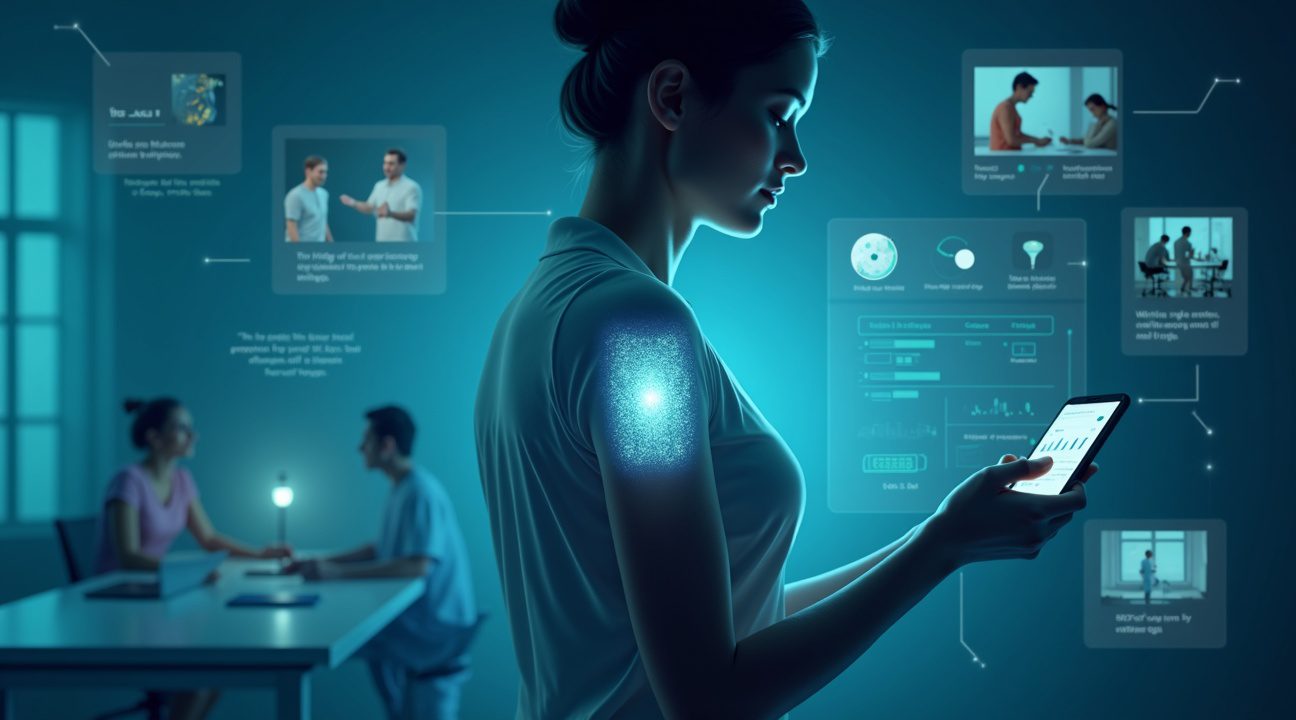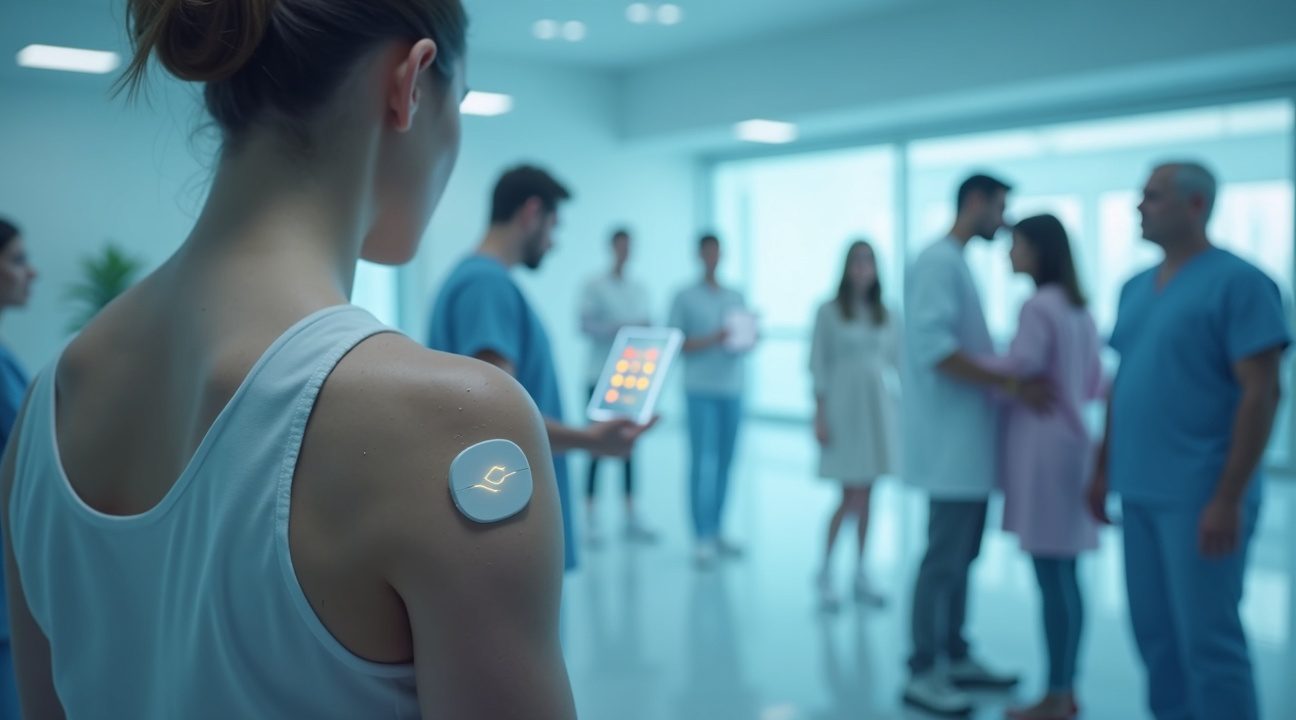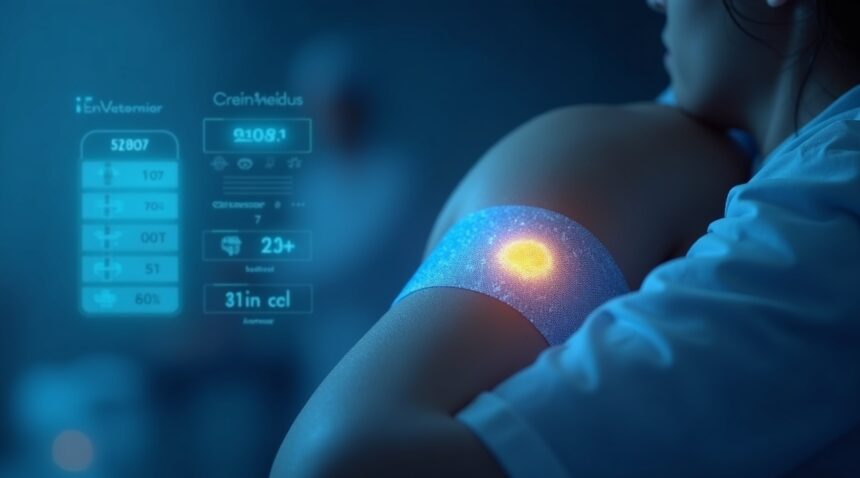South Korea has introduced a groundbreaking wearable patch that offers a painless and highly accurate method of monitoring blood glucose levels using advanced sweat analysis technology—potentially revolutionizing diabetes care for millions around the globe.
Key Takeaways
- Painless monitoring technology – These innovative patches analyze glucose from only one millionth of a liter of sweat, eliminating the need for uncomfortable finger pricks and minimizing skin irritation.
- Automatic medication delivery – Integrated microneedles respond to rising glucose levels by automatically delivering insulin or diabetes medication, removing the need for manual injections and enhancing convenience for patients.
- Cost-effective and eco-friendly design – Constructed with biodegradable silk and hydrogel, the patches are priced at just one-fifth of conventional glucose meters and provide real-time visual feedback through color changes—no batteries or electronics needed.
- Clinical accuracy validated – Human trials have confirmed a strong correlation between sweat-based measurements and traditional blood tests, with consistency maintained over their three-day usage period.
- Addresses global health challenge – This technology could significantly improve diabetes management for more than 371 million sufferers worldwide by overcoming common barriers to regular glucose monitoring, ultimately helping reduce complications and associated healthcare expenditures.
To learn more about the scientific development and implications of this innovation, visit this published article in Nature Materials.
Revolutionary Technology Delivers Painless Glucose Monitoring Through Sweat
South Korea has achieved a major breakthrough in diabetes management by creating wearable patches that monitor blood glucose levels through sweat analysis, eliminating the need for painful needle pricks. This innovative approach transforms how people with diabetes can track their glucose levels throughout the day, offering unprecedented convenience and comfort.
Advanced Sensor Technologies Enable Precise Detection
The groundbreaking patch incorporates three cutting-edge technologies that work together to deliver accurate glucose readings. Graphene-based sensors form the foundation of the device, providing exceptional sensitivity to detect glucose molecules in minimal amounts of sweat. These sensors complement hydrogel patches that collect and analyze sweat samples, while fluorescence-emitting microneedles enhance the detection process through advanced optical measurement techniques.
The patch demonstrates remarkable efficiency, requiring only one millionth of a litre of sweat to generate accurate glucose readings. This microscopic sample requirement means users don’t need to engage in intense physical activity or wait for significant perspiration to obtain reliable measurements. The technology represents a significant advancement in biomedical technology, positioning South Korea at the forefront of non-invasive medical monitoring solutions.
Flexible Design Ensures Comfort During Extended Use
The graphene patch stands out for its practical design features that prioritize user comfort and reliability. Its flexible, semi-transparent construction allows for seamless integration with daily activities while maintaining accurate monitoring capabilities. Users can wear the patch continuously without experiencing discomfort or interference with normal skin movement.
The device remains unaffected by skin deformation or physical activity, ensuring consistent performance regardless of the wearer’s movements. This stability addresses a common challenge faced by wearable health monitoring devices, which often struggle to maintain accuracy during physical activity or when positioned on areas of the body that experience frequent movement.
This innovation builds upon recent advances in smart health monitoring, similar to how modern devices can potentially save lives through continuous health tracking. The needle-free approach eliminates the daily discomfort and inconvenience associated with traditional glucose monitoring methods, while providing the continuous data necessary for effective diabetes management.
The South Korean development represents a paradigm shift in diabetes care, offering hope for millions of people who rely on frequent glucose monitoring. By replacing invasive testing methods with comfortable, continuous monitoring through sweat analysis, this technology has the potential to significantly improve quality of life for diabetes patients while encouraging better adherence to glucose monitoring protocols.

Smart Patch Automatically Delivers Medication When Glucose Levels Rise
South Korea’s most advanced glucose monitoring patch represents a breakthrough that goes beyond simple monitoring—it actively treats diabetes by delivering medication automatically. This innovative device combines continuous glucose detection with intelligent drug delivery through temperature-responsive microneedles, creating a comprehensive diabetes management system that responds in real-time to blood sugar fluctuations.
Multi-Parameter Monitoring Triggers Smart Drug Release
The patch’s sophisticated enzyme-based sensor system continuously tracks multiple biomarkers including glucose levels, humidity, pH, and temperature. These sensors work together to create a complete picture of the patient’s physiological state, ensuring accurate detection of high glucose episodes. When the system detects elevated glucose levels, it triggers an automatic drug release prompt that activates the integrated medication delivery system.
I find this multi-sensor approach particularly impressive because it reduces false positives that could lead to unnecessary medication administration. The system’s ability to cross-reference multiple parameters before initiating treatment demonstrates the careful engineering behind this biomedical technology advancement.
Microneedle Technology Revolutionizes Drug Delivery
The patch’s microneedle module represents a significant advancement in transdermal drug delivery, offering several key advantages over traditional injection methods:
- Painless administration eliminates injection anxiety and discomfort
- Enhanced drug absorption efficiency compared to conventional delivery methods
- Precise dosage control through temperature-responsive release mechanisms
- Reduced risk of infection from repeated needle use
- Improved patient compliance due to automated treatment
Research conducted on mice demonstrated remarkable results for this smart insulin administration system. Transdermal delivery of metformin through the patch’s microneedles showed significant, dose-dependent reduction in blood glucose levels compared to traditional administration methods. These findings suggest that the patch could deliver more consistent therapeutic outcomes than current treatment approaches.
The temperature-responsive microneedles represent a particularly clever design element. As glucose levels rise and trigger the drug release system, these tiny needles activate to deliver precise amounts of medication like insulin or metformin directly through the skin. This automatic therapy eliminates the need for patients to manually inject insulin or remember to take oral medications.
The patch’s ability to deliver drugs transdermally offers distinct advantages for diabetes treatment innovation. Traditional insulin injections require patients to puncture their skin multiple times daily, leading to injection site complications and reduced quality of life. This microneedle patch technology addresses these concerns while potentially improving medication effectiveness through more consistent delivery patterns.
Clinical implications extend beyond convenience improvements. The patch’s real-time response capability means it can address glucose spikes immediately, potentially preventing the dangerous complications associated with prolonged hyperglycemia. This proactive approach to diabetes management could significantly reduce long-term health risks for patients.
The system’s integration of monitoring and treatment functions into a single wearable device represents a fundamental shift in diabetes care philosophy. Rather than requiring patients to actively manage their condition through multiple daily interventions, this technology provides continuous, automated support that adapts to their body’s changing needs throughout the day.
Manufacturing considerations for this advanced patch include ensuring consistent microneedle performance, maintaining drug stability within the delivery system, and creating reliable sensor calibration across different environmental conditions. These challenges reflect the sophisticated engineering required to create a device that functions effectively in real-world conditions.
The patch’s potential impact on global diabetes management could be substantial, particularly for populations with limited access to healthcare infrastructure. Much like how advanced robotics are transforming industries, this smart patch technology could revolutionize diabetes treatment accessibility and effectiveness worldwide.
Future developments may expand the patch’s capabilities to include additional medications or biomarker monitoring, creating an even more comprehensive health management platform. The success of this diabetes treatment innovation could pave the way for similar automated therapeutic systems addressing other chronic conditions requiring continuous medication management.
Breakthrough Materials Make Monitoring Affordable and Eco-Friendly
I find the material science behind these patches fascinating, particularly how researchers have combined cutting-edge compounds to create something both practical and sustainable. The integration of graphene and biodegradable silk transforms traditional monitoring into a skin-like experience that feels natural against the body.
Advanced Materials Creating Flexible Solutions
Graphene sensors form the backbone of these innovative patches, offering exceptional conductivity while maintaining the flexibility needed for comfortable wear. These materials bend and move with natural skin motion, eliminating the rigid feel of traditional monitoring devices. Biodegradable silk adds another layer of environmental responsibility, ensuring the patches break down naturally after disposal rather than contributing to medical waste accumulation.
The combination creates a monitoring system that adapts to daily activities without causing irritation or discomfort. Users can exercise, shower, or sleep while wearing these patches, something impossible with conventional needle-based systems. Scientific advancements like these demonstrate how material innovation drives practical healthcare solutions.
Cost-Effective Production Through Smart Design
Hydrogels represent the real game-changer in affordability, enabling production costs at just one-fifth the price of standard electric glucose meters. These color-changing patches measure only 1 cm square yet deliver reliable results through simple visual feedback. The hydrogel responds to elevated glucose levels by shifting from colorless to yellow, creating an intuitive system that doesn’t require complex electronics or digital displays.
This visual approach proves particularly valuable for children and visually impaired users who might struggle with tiny digital readouts. The color change occurs gradually and distinctly, making detection straightforward even in varying light conditions. Single-use design eliminates infection risks associated with repeated needle punctures while maintaining sterile conditions for each application.
The painless monitoring capability addresses one of healthcare’s persistent challenges — patient compliance.
Key benefits of these patches include:
- Painless and irritation-free monitoring
- Visual color-change for easier glucose level detection
- Single-use to reduce infection risk
- Eco-friendly and biodegradable design
- No electronics or battery waste
Environmental benefits extend beyond biodegradable materials. The patches require no batteries, electronic waste disposal, or specialized recycling procedures. Manufacturing processes consume less energy compared to electronic alternatives, and the compact size reduces packaging requirements. This eco-friendly approach aligns with growing demands for sustainable medical solutions without compromising effectiveness.
The technology represents a significant step forward in making health monitoring accessible to broader populations. Cost reduction combined with ease of use opens possibilities for widespread deployment in developing regions where expensive electronic devices remain impractical. These innovations continue pushing the boundaries of what’s possible in health monitoring technology, proving that sophisticated healthcare doesn’t always require complex machinery.

Clinical Testing Proves Accuracy Matches Traditional Blood Tests
Human trials have demonstrated that sweat glucose detected by the patch shows reliable correlation with conventional blood-based measurements. Statistical analysis confirms the device’s precision matches traditional methods, representing a significant breakthrough in non-invasive glucose monitoring technology.
The patch maintains its sensitivity after repeated measurements, enabling multiple uses without any loss in accuracy. This consistency proves essential for diabetic patients who require frequent monitoring throughout the day. Laboratory studies validate the device’s reliability through comprehensive testing protocols that include both healthy human subjects and diabetic mice models.
Performance Data and Real-World Applications
Clinical testing reveals several key performance indicators that position this technology as a viable alternative to traditional blood glucose monitoring:
- Statistical validation demonstrates strong correlation between sweat-based and blood-based glucose readings across diverse patient populations
- Repeated measurements maintain consistent accuracy levels over extended testing periods
- Animal models confirm the patch’s effectiveness in detecting glucose fluctuations in diabetic subjects
- Human pilot studies show successful glucose tracking in both healthy individuals and those with diabetes
- Device accuracy remains stable across varying environmental conditions and user activity levels
The fluorescence patch emits visible signals in response to changes in blood glucose levels, providing immediate visual feedback to users. This innovative approach eliminates the need for complex electronic components while maintaining high precision. Users can monitor results through a dedicated smartphone app that captures and analyzes the fluorescent signals, creating a comprehensive glucose tracking system.
Biodegradability adds another practical advantage, as the patch dissolves completely within approximately three days. This timeframe aligns perfectly with recommended replacement schedules for continuous glucose monitoring devices. The environmentally friendly design reduces medical waste while ensuring optimal performance throughout the device’s lifespan.
Research teams conducted extensive validation studies comparing patch readings with standard glucometer measurements. Results consistently show correlation coefficients exceeding industry standards for medical devices. The sweat glucose correlation proves particularly robust during periods of glucose fluctuation, when accurate monitoring becomes most critical for patient safety.
Animal models provided crucial insights into the patch’s performance under controlled conditions. Diabetic mice studies revealed the device’s ability to track glucose changes in real-time, responding to both natural fluctuations and induced glucose spikes. These findings support the patch’s potential for continuous monitoring applications in human subjects.
The human pilot study enrolled participants across different age groups and diabetes management levels. Each participant wore the patch for multiple monitoring sessions while simultaneously using traditional blood glucose meters for comparison. Data analysis confirmed the patch’s reliability across this diverse population, with particular success noted in detecting both gradual glucose trends and rapid changes.
Clinical testing protocols addressed potential interference factors that could affect accuracy. Researchers evaluated the impact of physical activity, ambient temperature, humidity levels, and individual sweat composition variations. The patch demonstrated consistent performance across all tested conditions, confirming its suitability for real-world use.
Statistical validation employed rigorous analytical methods to ensure the correlation between sweat and blood glucose readings meets medical device standards. Multiple regression analyses accounted for variables such as hydration status, medication use, and individual metabolic differences. These comprehensive evaluations support the patch’s clinical reliability and safety profile.
The device’s ability to maintain accuracy through repeated measurements addresses a common limitation of disposable monitoring solutions. Users can rely on consistent readings throughout the patch’s three-day lifespan, reducing the frequency of device replacement compared to single-use alternatives. This feature particularly benefits individuals requiring frequent glucose monitoring, such as those managing insulin-dependent diabetes.
Integration with smartphone technology enhances the patch’s practical value by enabling data logging, trend analysis, and sharing capabilities with healthcare providers. The app processes fluorescent signals through image analysis algorithms, converting visual data into precise glucose measurements. This approach combines the simplicity of visual monitoring with the sophistication of digital health tracking, creating a user-friendly solution for continuous glucose management.
https://www.youtube.com/watch?v=3DzO7M9pF1M

Technology Addresses Massive Global Health Challenge
Diabetes presents one of healthcare’s most pressing challenges, affecting over 371 million people worldwide and placing 29.1 million Americans in a daily struggle with blood sugar management. The burden extends far beyond numbers, creating significant barriers that prevent effective self-care and monitoring.
Current medical guidelines demand rigorous testing schedules that many patients find difficult to maintain. Type 1 diabetes patients must monitor their glucose levels 4–8 times daily, while those with type 2 diabetes need to check at least twice daily. This frequent monitoring creates a cycle of pain, anxiety, and medical waste that often leads to poor compliance rates and deteriorating health outcomes.
Breaking Down Traditional Monitoring Barriers
Traditional finger-stick glucose monitoring creates multiple obstacles for patients managing diabetes. The constant needle pricks cause physical discomfort, emotional stress, and often result in callused fingertips that make future testing even more challenging. Many patients admit to skipping tests due to pain, particularly children and elderly individuals who may have difficulty handling the lancets properly.
Medical waste accumulates rapidly with conventional monitoring methods. Each test generates used lancets, test strips, and alcohol swabs that require proper disposal. Beyond environmental concerns, the ongoing cost of supplies creates financial strain for many families managing this chronic condition. The psychological barrier proves equally significant, as some patients develop anxiety around testing that affects their willingness to maintain proper monitoring schedules.
Learning from Past FDA Failures
The FDA’s history with non-invasive glucose monitoring reveals important lessons about patient acceptance and technological effectiveness. The GlucoWatch, an early attempt at needle-free monitoring, failed primarily due to skin irritation and discomfort that patients found intolerable. This device required frequent calibration and caused allergic reactions in many users, demonstrating that merely eliminating needles isn’t enough without addressing overall comfort and usability.
South Korea’s innovative patch technology addresses these historical shortcomings by focusing on truly painless monitoring. The patch eliminates skin irritation concerns while providing continuous glucose data without the need for calibration blood draws. This represents a significant advancement over previous attempts at non-invasive monitoring that couldn’t deliver both accuracy and comfort.
The new patch technology positions itself to transform diabetes management by removing the primary barriers that prevent consistent monitoring. Patients who previously avoided testing due to pain or inconvenience can now maintain the frequent monitoring schedules their doctors recommend. This improvement in compliance directly translates to better glucose control, reduced complications, and enhanced quality of life.
Healthcare systems worldwide recognize that effective diabetes management depends heavily on patient self-monitoring compliance. When patients skip tests or reduce monitoring frequency, their risk of serious complications increases dramatically. The patch technology offers a solution that could significantly reduce healthcare costs by preventing diabetes-related hospitalizations and emergency interventions.
The innovation comes at a critical time when diabetes rates continue climbing globally. Scientific advancements in biomedical technology like this patch demonstrate how engineering solutions can address fundamental healthcare challenges. By eliminating the pain and inconvenience associated with traditional monitoring, the technology promises to revolutionize how millions of people manage their diabetes daily.
Early indicators suggest this patch could achieve the widespread adoption that previous non-invasive devices failed to reach. The combination of painless operation, continuous monitoring, and elimination of medical waste addresses the core concerns that have historically prevented patients from maintaining optimal glucose monitoring schedules. This technological breakthrough represents more than just convenience—it offers a pathway to significantly improved health outcomes for diabetes patients worldwide.

Sources:
Asian Scientist: “Graphene Patch Monitors Sugar Levels In Sweat”
Biopharma Dive: “South Korean, US researchers develop diabetes skin patch”
DRWF: “Sweat patch blood glucose monitor could replace finger prick test”
The Pharmaceutical Journal: “Disposable diabetes patch measures sweat glucose and delivers metformin”
The Scientist: “A Noninvasive Glucose Monitor for Managing Diabetes”
Science News Explores: “New hydrogel patch might replace some finger-prick testing of blood sugar”


